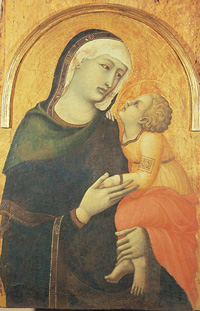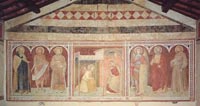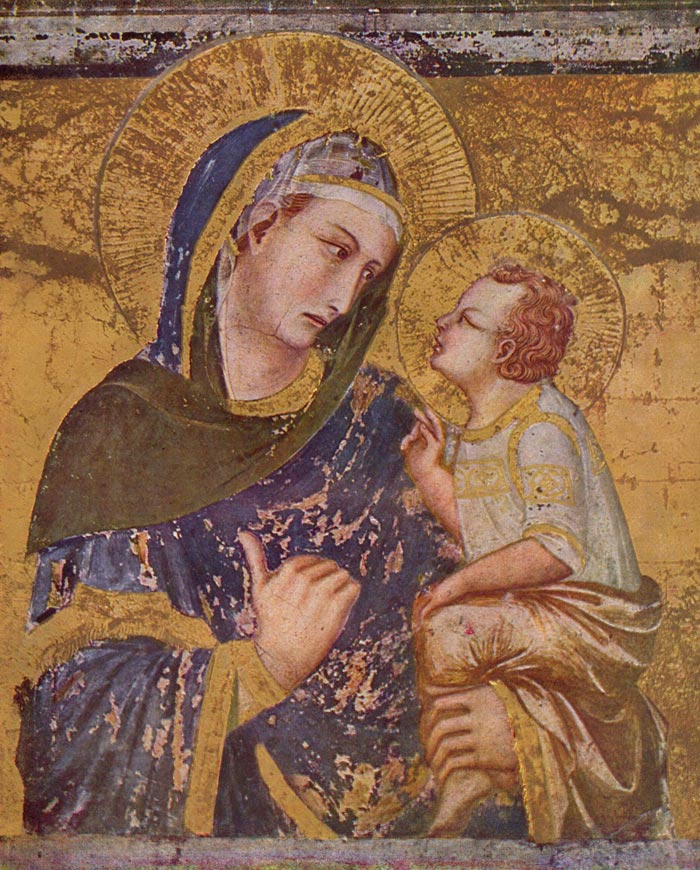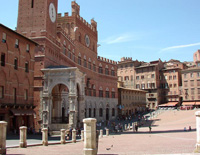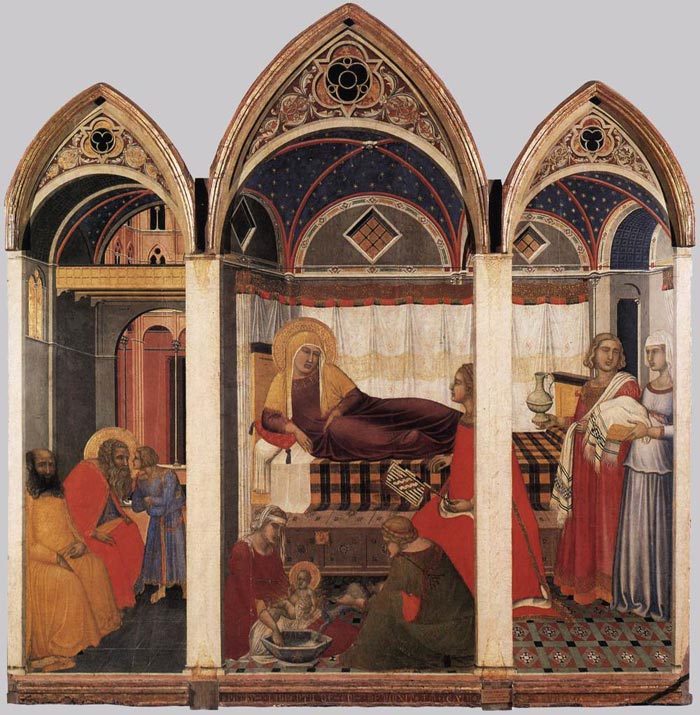 |
||
Pietro Lorenzetti, The Birth of Mary, 1342, Museo dell'Opera del Duomo, Siena [1]
|
||
Pietro Lorenzetti |
| Pietro and Ambrogio, two 14th-century Italian painters who were brothers, belonged to the Sienese school dominated by the stylized Byzantine tradition developed by Duccio di Buoninsegna and Simone Martini. Pietro trained under Duccio di Buoninsegna and participated in the decoration of the lower Basilica at Assisi. He then returned to Tuscany in 1320 where he left behind the testimony of his great artistic ability. Little is known of Pietro Lorenzetti's life other than that he was born in Siena in the late 13th century (c. 1280/90),[1] died there (possibly) in 1348 a victim of the first Black Death pandemic then devastating Europe, and had a younger brother, Ambrogio, also an artist. That the men were brothers was unknown to Vasari because he misread Pietro's surname on a painting in Pistoia's church of San Francesco as Laurati.[2] Thus the kinship between the artists was missed. Pietro was known to have been a young man in 1306 as he was still being referred to as Petruccio di Lorenzo. However, he was at least 25 at the time because he was paid directly.[3] Pietro worked in Assisi, Florence, Pistoia, Cortona, and Siena, although the precise chronology is unknown.[4] His work suggests the influence of Duccio (in whose studio he may have worked, possibly alongside Simone Martini), Giotto, and Giovanni Pisano [5].
|
| Immersed in the clay landscape of the Crete Senesi rises Castiglione d'Orcia, a small medieval village of the Sienese countryside. An oasis not just of natural beauty, but also artistic beauty, including the Rocca di Tentennano fortress, an imposing structure built in the 13th century as a defensive outpost for the whole valley. Inside this structure, is the Sala d'arte San Giovanni: an important exhibit for gaining a deeper understanding of, and admiring, the masterpieces of the Sienese school between the 14th and 15th centuries.
In particular, a prestigious work of Pietro Lorenzetti stands out, the Madonna and Child. This panel painting, after an attentive, year-long restoration, returned to its original splendour next to paintings of the calibre of Simone Martini, Il Vecchietto, and Giovanni di Paolo.
|
Pietro Lorenzetti, Madonna col Bambino, 1330 circa, tempera e oro su tavola, 73x52 cm, Castiglione d'Orcia, pieve dei Santi Stefano e Degna
|
|
Monticchiello still retains its old walls, towers and castle, the village inside the fortifications has maintained intact its medieval characteristics. Walking down the main street, there is the church of S. Agata. The 13th century Church of Santo Leonardo e Cristóforo, with a Gothic facade, contains an altar-piece of the Madonna con bambino by Pietro Lorenzetti. The work belongs to the beginning of Pietro's career, towards the end of the decade 1310-1320, years during which he gradually freed himself from Duccio's influence, although, of course, the foundation of the style of the elder of the Lorenzetti brothers remained. Here, the expressive and plastic strength we can admire is the same as in the Assisi scenes. The folds of the clothes are not only, far from it, the pretext for elegant arabesques, but participate in the construction of the forms and their volumes. he silent dialogue between the Madonna and the Child acquires extreme dramatic force. Their two faces are suitably glued to each other by the tension of their gazes. The Child's concentration on his mother imposes on him an attitude that he could hardly maintain for a prolonged period. Rare for the time, the Child is depicted perfectly in profile.[2]
|
||
| Pietro Lorenzetti, Annunciazione dei Santi in the Chiesa di San Michele in Castiglione del Bosco, Montalcino. The far-reaching frescoes, discovered around 1876, were executed in 1345, as the inscription under the central panel of the Annunciation states. On the right are Saints Michael the Archangel, Bartholomew and Francis of Assisi and on the left Saints Anthony Abbot, John the Baptist and Stephen. |
||
| The Nativity of the Virgin is a painting by the late medieval painter Pietro Lorenzetti, dating from around 1335–1342. The painting is now housed in the Museo dell'Opera del Duomo of Siena. It is the artist's last documented work.
Formally a triptych, in fact it is a single scene. In the centre St. Anne in a position similar to the Etruscan sarcophags. The composition is Byzantine but the painting as a whole is Italian showing the influence of Giotto.
|
Pietro Lorenzetti, Natività della Vergine, 1342, tempera e oro su tavola, 188x183 cm, Siena, Museo dell'Opera del Duomo |
|
| Madonna dei Tramonti, 1330 |
||
|
||
Pietro Lorenzetti, Madonna dei Tramonti, San Francesco, Assisi |
||
Madonna dei Tramonti is a 1330 Madonna fresco by Pietro Lorenzetti. It is located in the Basilica of San Francesco d'Assisi in Assisi. The fresco is accompanied by a frescoed niche containing the liturgical implements.
|
||
|
[1] Quest'opera è nel pubblico dominio. |
||||
|
||||
Podere Santa Pia
|
Podere Santa Pia
|
The vast and endless golden rolling hills of the Tuscan Maremma
|
||
Early morning light at the private swimming pool at Podere Santa Pia
|
A bigger splash in swimming pool at Podere Santa Pia, southern Tuscany
|
A bigger splash in the pool, Podere Santa Pia, Castiglioncello Bandini, Cinigiano, Tuscany
|
||
Podere Santa Pia, situata sulle splendide colline del valle d'Ombrone nel cuore della Maremm a |
||||
 |
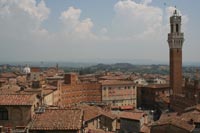 |
|||
Siena, duomo
|
Siena, Palazzo Publicco
|
Siena, Piazza del Campo
|
||
 |
||||
| The valley below Santa Pia is a classic example of the Tuscan landscape, with endless hills, cypresses, wine, corn fields and streams, offering splendid views up to the Tyrrhenian coast and Monte Christo |
||||
Siena in the Middle Ages Siena in the Renaissance |
||||
This article uses material from the Wikipedia article Ambrogio Lorenzetti. |
||||


